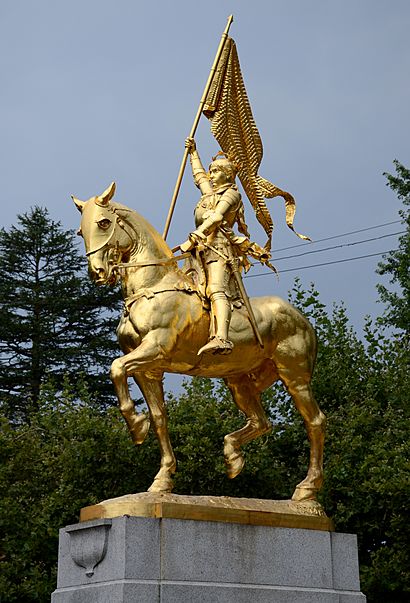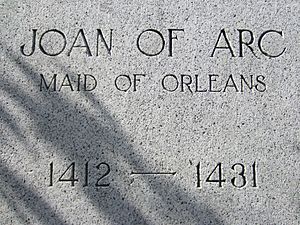Equestrian statue of Joan of Arc (Portland, Oregon) facts for kids
Quick facts for kids Joan of Arc |
|
|---|---|

The sculpture in 2015
|
|
| Artist | Emmanuel Frémiet |
| Type | Sculpture |
| Medium | Sculpture: Bronze, copper Base: Granite |
| Subject | Joan of Arc |
| Location | Portland, Oregon, United States |
| 45°31′35″N 122°37′23″W / 45.52633°N 122.62301°W | |
The Joan of Arc statue, also called Joan of Arc, Maiden of Orleans, is an outdoor sculpture in Portland, Oregon. It's a copy of a famous statue by Emmanuel Frémiet from 1874. This statue shows Joan of Arc riding a horse.
The sculpture was given to Portland by Henry Waldo Coe. He saw the original statue in Paris and wanted one for his city. Portland's copy arrived from France in 1924. It was officially shown to the public on Memorial Day in 1925. This was done to honor the American soldiers, known as "Doughboys," who fought in World War I.
Contents
What Does the Joan of Arc Statue Look Like?
The Joan of Arc statue is an outdoor sculpture. You can find it in Coe Circle, a special spot in Portland's Laurelhurst neighborhood. It stands where Northeast Cesar E. Chavez Blvd. and Glisan Street meet.
This statue is one of several copies of Emmanuel Frémiet's original work. His first statue, called Jeanne d'Arc, was made in 1874. It is a gilded bronze statue in Paris, France.
Materials and Size of the Statue
Portland's statue is made of bronze. It is about 12 feet (3.7 meters) tall. It is also about 5.5 feet (1.7 meters) wide and 9 feet (2.7 meters) long. The flag that Joan of Arc holds in her hand is made from copper.
The statue sits on a large base made of granite. This base is about 8 feet (2.4 meters) tall. It is also about 3 feet (0.9 meters) wide and 9 feet (2.7 meters) long.
The Story of the Statue's Base
The city of Portland could not pay for the granite base. So, Dr. Coe's wife and mother paid for it themselves. It cost $4,000 at that time.
To choose the best design for the base, a contest was held. The city art commission and local architects helped organize it. Margaret Goodin Fritsch won the contest. She was the first woman to graduate from the School of Architecture at the University of Oregon. Her winning design was then used. The Blaesing Granite Works company built the granite base.
History of the Joan of Arc Statue
The Joan of Arc statue was placed in Coe Circle in 1925. It was one of four statues that Henry Waldo Coe gave to the City of Portland. This particular statue was made using the original molds from Frémiet's statue. Dr. Coe saw the first statue during a visit to France.
Portland's statue arrived from France in 1924. It was officially dedicated on Memorial Day, May 30, 1925. The dedication honored the "Doughboys" of World War I.
Why Joan of Arc?
Dr. Coe chose to give a statue of Joan of Arc for a special reason. She was seen as the patron saint, or protector, of the Doughboys. These American soldiers fought in Europe during World War I.
It is said that the Doughboys would even sing a song called "Joan of Arc, They Are Calling You" as they marched into battle. Dr. Coe believed this song helped the French soldiers. He said it "...had much to do in reviving the drooping spirits of the French and bringing victory out of defeat." At the statue's unveiling ceremony, a group called the Royal Rosarian quartet sang that very song.
Restoring the Statue's Shine
Over many years, the bright gold leaf on the statue faded away. Eventually, there was no trace of its original shine. In 1993, the statue was checked by the Smithsonian Institution's "Save Outdoor Sculpture!" program.
In 2002, efforts were made to restore the statue. Money was raised, and a grant of $24,000 was received. This allowed the city of Portland to bring the statue back to its former glory. The small flag in Joan's right hand was replaced. The laurel wreath on her head was also replaced. And the beautiful gold leaf was put back on the statue.


